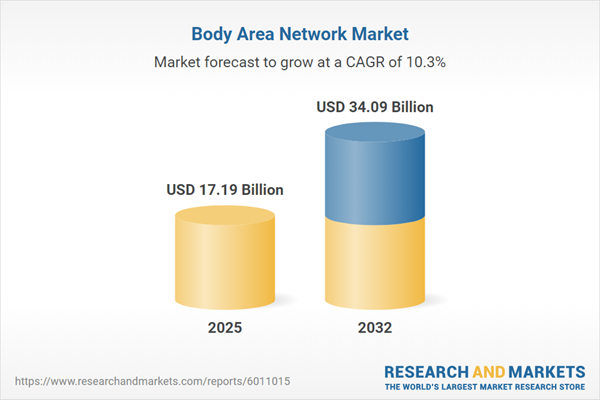Speak directly to the analyst to clarify any post sales queries you may have.
Body area network (BAN) technologies are driving advancements in personalized healthcare and connectivity across multiple industries. As device miniaturization, flexible electronics, and wireless protocols evolve, senior leaders are rethinking digital strategies, operational agility, and product design to capture value in medical, military, sports, and consumer wellness domains.
Market Snapshot: Body Area Network Market Growth and Outlook
The global body area network market is growing, supported by strong momentum in digital healthcare adoption, sensor innovations, and the integration of AI-driven analytics. The latest research reveals a shift towards connected medical devices, robust remote monitoring platforms, and new use cases beyond traditional medicine, all expanding the overall market landscape. This offers stakeholders a diverse set of monetization opportunities and longer-term competitive positioning.
Scope & Segmentation
This report delivers a comprehensive analysis of the body area network market, with insights segmented by applications, node types, communication technologies, frequency bands, and regional markets.
- Applications: Chronic disease management, remote patient monitoring, telemedicine, military and defense readiness, combat simulation diagnostics, soldier fatigue and vital sign monitoring, health and wellness, athlete performance, sleep and stress tracking.
- Node Types: Implantable cardiac devices, drug delivery solutions, neurostimulators, ingestible capsules and pH sensors, wearables including smart watches, fitness bands, and smart clothing.
- Communication Technologies: Wired and wireless options, each optimized for specific operational contexts and power requirements.
- Frequency Bands: 2.4 GHz (Bluetooth, Wi-Fi), 400 MHz (medical implant communications, amateur radio), UltraWideband for high-precision tracking and localization over varying distances.
- Geographical Coverage: Americas (US, Canada, Mexico, Brazil, Argentina, Chile, Colombia, Peru), Europe (UK, Germany, France, Italy, Spain, Netherlands, Sweden, Poland, Switzerland, Russia), Middle East and Africa (UAE, Saudi Arabia, Qatar, Turkey, Israel, South Africa, Nigeria, Egypt, Kenya), Asia-Pacific (China, India, Japan, South Korea, Australia, Indonesia, Thailand, Malaysia, Singapore, Taiwan).
- Key Players: Abbott Laboratories, Medtronic plc, Koninklijke Philips N.V, GE HealthCare Technologies Inc, Boston Scientific Corporation, Qualcomm Incorporated, Texas Instruments Incorporated, STMicroelectronics N.V, NXP Semiconductors N.V, Analog Devices, Inc.
Key Takeaways for Senior Leaders
- Convergence of biomedical engineering and telecommunications is enabling continuous, real-time health monitoring, supporting proactive care and operational readiness in demanding environments.
- BAN integration now spans military, sports, and wellness use cases, equipping end-users with actionable insights through advanced analytics and AI algorithms.
- Technical progress in battery lifespans, energy harvesting, and low-power wide-area networks reduce maintenance and enable applications in remote or high-mobility settings.
- Regulatory harmonization and open standards drive interoperability, fostering scalable deployment and facilitating regional market entry strategies.
- Strategic alliances between device manufacturers, semiconductor suppliers, and software developers are reshaping solution ecosystems and accelerating product innovation cycles.
- Supply chain resilience remains a top priority, particularly in the face of trade policy shifts and component cost volatility.
Tariff Impact on BAN Ecosystem and Supply Chains
Recent United States tariff regimes have increased the cost of internationally sourced BAN components, including semiconductors and specialized polymers. Companies are diversifying supplier bases and strengthening partnerships with domestic and near-shore foundries to mitigate risks. These actions encourage investment in modular design and flexible sourcing models, supporting operational continuity and resilience regardless of future trade shifts.
Methodology & Data Sources
The research combines secondary data from filings, peer-reviewed publications, and patents with in-depth interviews of executives, R&D leads, and end-users. Analytical tools, scenario workshops, and benchmarking underpin data integrity, with results cross-verified and peer-reviewed for quality assurance.
Why This Report Matters
- Enables data-driven strategy by delivering actionable insights on body area network market dynamics, innovation pathways, and regulatory impacts.
- Supports informed procurement, product development, and risk management decisions for senior leaders in healthcare, defense, and technology sectors.
- Offers a clear view of emerging business models, competitive positioning, and supply chain strategies to help organizations capture new value.
Conclusion
The body area network market is advancing rapidly due to the convergence of sensor technology, smart connectivity, and advanced analytics. This report equips decision-makers with the market intelligence needed for strategic action and sustainable growth.
Additional Product Information:
- Purchase of this report includes 1 year online access with quarterly updates.
- This report can be updated on request. Please contact our Customer Experience team using the Ask a Question widget on our website.
Table of Contents
3. Executive Summary
4. Market Overview
7. Cumulative Impact of Artificial Intelligence 2025
List of Figures
Samples

LOADING...
Companies Mentioned
The key companies profiled in this Body Area Network market report include:- Abbott Laboratories
- Medtronic plc
- Koninklijke Philips N.V
- GE HealthCare Technologies Inc
- Boston Scientific Corporation
- Qualcomm Incorporated
- Texas Instruments Incorporated
- STMicroelectronics N.V
- NXP Semiconductors N.V
- Analog Devices, Inc
Table Information
| Report Attribute | Details |
|---|---|
| No. of Pages | 195 |
| Published | October 2025 |
| Forecast Period | 2025 - 2032 |
| Estimated Market Value ( USD | $ 17.19 Billion |
| Forecasted Market Value ( USD | $ 34.09 Billion |
| Compound Annual Growth Rate | 10.2% |
| Regions Covered | Global |
| No. of Companies Mentioned | 11 |









